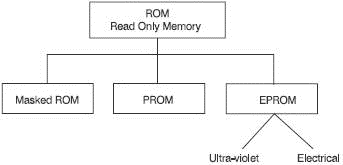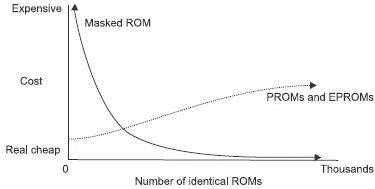Книга: Introduction to Microprocessors and Microcontrollers
Three types of ROM
Three types of ROM
All ROMs are used to store information on a more-or-less permanent basis. In use, the ROM can be read but new information cannot be stored in it. In other words, we cannot write to it (see Figure 6.17).

Figure 6.17 Three types of ROM
Masked ROM
A masked ROM is manufactured to our specification and cannot be changed. We must be very sure that the information is correct before it is made otherwise it all goes in the waste bin and the person responsible is looking for a new job. The initial cost is necessarily high due to the expense of the tooling required. It is only worthwhile if at least a few thousand identical chips are required (see Figure 6.18).

Figure 6.18 The economics of ROM choice
Programmable ROM (PROM)
This chip is supplied with all the data held at zero by means of small internal fuses. When one of the fuses is blown, the associated bit changes from 0 to 1. To blow the fuses a piece of programming equipment is needed. This equipment can be purchased quite cheaply if only one PROM is to be programmed at a time. If a larger throughput is needed then this will inevitably increase the cost of the equipment. Once the fuse is blown, it cannot be repaired so if you make a mistake, the chip is wasted.
The ROM is useful for low volume production because the initial costs are much lower than the masked ROM but you do have to program them yourself.
Erasable programmable ROM (EPROM)
As the name would suggest, this chip allows us to program it, then change our mind and try again. To erase the data there are two methods – ultraviolet light or electrical voltage pulses. EPROMs are ideal for prototyping since it is so easy to change the data to make modifications.
The UVEPROM
The chip is bombarded with ultraviolet light via a transparent window on the chip. A specially constructed EPROM eraser provides the light. We pop the chip in, close the lid and switch on the timer. After a few minutes, the data is erased. When erased, all the data output is set to 1. We then put the chip into an EPROM programmer, usually the same piece of gear that was used to program the PROM. We can feed in the new data and within a couple of minutes, we have finished the process.
They can be erased and reprogrammed about 700 times before they become increasingly reluctant to erase and their life is over. Once programmed, the data is safe for about seven years. For long term storage, it is best to reload them or, better still, use a masked ROM if available.
A safety note: be extremely careful not to expose your eyes to the ultraviolet light from the eraser. The wavelength of 253.7 nm is very dangerous.
Electrically erasable programmable ROM (EEPROM)
This chip uses electrical voltage pulses as inputs to clear the previous data and is then reprogrammed in the same way as the UVEPROM. It has the added advantage that individual parts of the data can be reprogrammed without deleting everything first as is the case with the ultraviolet version. EEPROM can be found as serial access (SAM), as well as the more usual random access.
The reprogramming can be done while installed in the microprocessor-based system. It does not need a separate programmer. Their disadvantage is that they are slow to program and have a limited number of reprogramming cycles.
- A flip-flop or bistable
- A register
- Shift registers
- Rotate registers
- Memories
- RAM
- Accessing memory
- Two types of RAM
- Memory organization
- Three types of ROM
- Pin layout of an EPROM
- Pin layout of a SRAM
- Pin layout of a DRAM
- Some more memories that don’t fit into the general pattern
- Memory maps
- Quiz time 6
- 8.3.2 Data Flow Types
- Инструкция INSERT INTO ... FROM ... UNION ...
- Appendix C. ICMP types
- 1.2.2 ROM
- Creating CDs from the Command Line
- 7.3.2. EEPROM и флэш-память
- Глава 4. Этаж Promotion
- Как назначить логическому диску или CD-ROM другую букву?
- Я переписал ISO-образ загрузочного диска на CD-RW и выставил в BIOS загрузку с CD-ROM. Но при перезапуске компьютера нач...
- Chapter 2. Four Puzzles From Cyberspace
- Part Three - Latent Ambiguities
- Installing from CD or DVD




